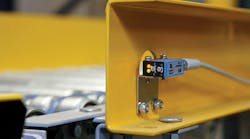In addition to specifying the right sensor for an application, engineers must ensure that the chosen sensor fits into a defined mounting space. Users must identify and understand any mounting constraints and select a mounting method accordingly. Fortunately, most sensor types are available in various form factors with flexible mounting options.
In many cases, mounting accessories are available to mount the sensor in a variety of orientations. It is common for the sensor supplier to offer specific mounting brackets for each sensor-housing type. These usually provide great value when compared to the time and money required for custom fabrication of a bracket.
Despite sensor mounting flexibility, mounting restrictions often play a part in sensor selection. The design constraints of an assembly machine may only allow the smallest of proximity sensors to fit, eliminating most other options. At the other end of the scale, a large conveyor with varying sized objects may require a photoelectric sensor emitting a powerful and wide beam to see all the targets from a considerable distance.
Applications with temperature extremes—such as sensors mounted near ovens—may also effect sensor mounting location, requiring the sensor to be located up to five meters away from the target.
Andrew Waugh is Safety and Sensor Product Manager at AutomationDirect, Cumming, Ga.
